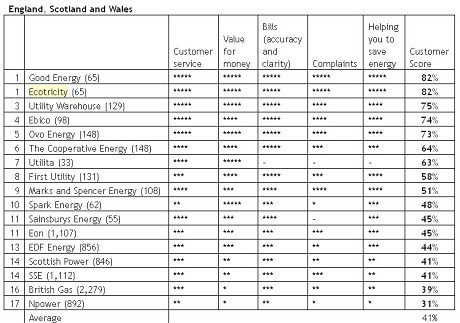The Best and Worst Energy Companies
Post on: 15 Июль, 2015 No Comment

During the recent financial crisis, crude oil prices collapsed from almost $150 to $30. Now we are observing a strong recovery in the economy, and energy prices are catching up. Moreover, due to the political instability in North Africa and the Middle East, oil passed the $100 threshold last week. If the trend continues, it is possible for oil prices to reach their pre-crises levels in the near-future. Legendary investors George Soros and Jim Rogers are among the several hedge fund managers who are bullish about commodities. T. Boone Pickens has been investing in energy stocks. John Burbanks Passport Capital is extremely bullish about energy shares (See Passports bullish comments about oil ).
We analyzed large-cap U.S.-based companies that are in the oil and gas business. Thirty-one companies are included in this research. Our ranking criteria includes market capitalization, current and forward P/E ratios, dividend yield, EPS Growth, PEG, profit margin and Beta values. The average YTD return of these stocks is 15%.
Highest Market Capitalization: Exxon (NYSE:XOM ) is the largest company with a current market cap of $430 billion, followed by Chevron (NYSE:CVX ) ($205 billion) and Schlumberger Limited (NYSE:SLB ) ($126.37 billion).
Lowest Market Capitalization: The smallest companies in our research list are all engaged in the oil and gas drilling and exploration business. Diamond (NYSE:DO ) has a market cap of $10.79 billion, followed by Concho (NYSE:CXO ) and Continental (NYSE:CLR ), each of which have market caps of $11.24 billion and $11.74 billion, respectively.
Highest Forward P/E Ratio: Kinder Morgan (NYSE:KMP ) has the highest forward P/E ratio of 32.70, followed by Continental Resources (29.63) and Concho Resources (28.97). Forward P/E will be lower than the current P/E if investors expect the profits to grow in the future. Based on the current P/E ratios, these values imply an expected profit increase of almost 100% for Kinder, and 50% for Continental and Concho.
Lowest Forward P/E Ratio: Chevron has the lowest forward P/E ratio of 8.79, followed by Marathon (NYSE:MRO ) (9.30) and Valero Energy (NYSE:VLO ) (9.39). These estimates indicate a 20% profit increase for Chevron, a 50% increase for Marathon and an almost 90% profit increase for Valero.
The Best
Best Dividend Yield: Energy Transfer Partners (NYSE:ETP ) has the best dividend yield of 6.63%, followed by Kinder Morgan (6.17%) and Enterprise Products Partners (NYSE:EPD ) (5.44%).
Lowest P/E Ratio: The major integrated oil and gas companies have the lowest current P/E ratios. ConocoPhillips (NYSE:COP ) has the lowest P/E ratio of 10.16, followed by Chevron (10.77) and Exxon (13.74). For a value investor, these companies mean safe yet high returns.
Lowest PEG: ConocoPhillips has the lowest PEG of 0.46, followed by Chevron (0.60), and Concho (0.87). These low PEG values might indicate that these stocks are undervalued. Note that unlike the P/E ratio, PEG is based on estimated future profits.
Best EPS Growth in the Last Five Years: Concho has the highest EPS growth rate of 44.42%. Next is Southwestern Energy (NYSE:SWN ) with EPS growth rate of 38.49%. FMC Technologies (NYSE:FTI ) ranks third with an EPS growth rate of 35.81%.
Best Profit Margin: Average profit margin of the companies included in our research is 14%. The following companies have profit margins higher than 20%: Diamond Offshore (28.75%), Continental (27.51%), Concho (27.12%), Apache (NYSE:APA ) (26.12%), Noble Energy (NYSE:NBL ) (23.99%), Southwestern (23.87%), Devon (NYSE:DVN ) (23.47%), Spectra Energy (NYSE:SE ) (22.71%), El Paso (EP) (22.57%), Occidental (NYSE:OXY ) (21.40%), and Pioneer (NYSE:PXD ) (20.88%).
Lowest Beta: Beta is a measure of volatility. It indicates the correlation between the stock price and market index. The average Beta of the energy stocks included in our analysis is 1.06. A lower Beta usually indicates a safer return. Kinder Morgan has the lowest Beta of 0.30, followed Southwestern and Exxon, each of which has Beta values of 0.45 and 0.49, respectively.
The Worst
Worst Dividend Yield: Southwestern, Continental Resources, Concho Resources, Cameron (NYSE:CAM ), and FMC Technologies (FTI ) paid no dividends last year.
Highest P/E Ratio: Some independent oil and gas companies have very large P/E ratios: EOG Resources (NYSE:EOG ) has the highest P/E ratio (177.38), followed by Kinder Morgan (59.07) and Anadarko (NYSE:APC ) (53.43). A high P/E ratio that is well above industry average might imply an overvalued stock. Therefore one needs to careful when buying these energy stocks.
Highest PEG: Energy Transfer Partners (ETP ) has the highest PEG of 13.21, followed by Kinder Morgan (7.32) and Anadarko (5.92). PEG is favored by many investors over the price/earnings ratio because it also accounts for earnings growth. A higher PEG implies that these stocks are overvalued.
Worst EPS Growth in Last 5 years: There are some companies whose earnings deteriorated in the last five years. EOG Resources performed the worst (-34.24%), followed by Valero Energy (VLO ) (-22.69%) and Anadarko (-18.07%).
Worst Profit Margin: While most energy companies are very profitable, the following companies have the lowest profit margin: Williams (NYSE:WMB ), (-9.53%), Valero (1.12%), EOG Resources (2.63%), Murphy Oil (NYSE:MUR ) (3.42%), Marathon (3.49%), and Enterprise Products (4.10%).
Highest Beta: A high Beta usually indicates a more volatile stock price. Most energy companies tend to have low Betas, while the following companies have Beta values higher than 1.5: Pioneer Natural, Continental Resources, Baker Hughes (NYSE:BHI ) and Cameron International (CAM ) have beta values of 1.76, 1.68, 1.50, and 1.53 respectively.
Disclosure: I have no positions in any stocks mentioned, and no plans to initiate any positions within the next 72 hours.














